Analyzing and Responding to Client Health Information
VerifiedAdded on 2023/01/06
|8
|2426
|42
AI Summary
This document provides a comprehensive guide on how to analyze and respond to client health information. It covers the importance of vital signs, assessments, and documentation. The document includes different scenarios and their potential complications. It is suitable for healthcare professionals and students.
Contribute Materials
Your contribution can guide someone’s learning journey. Share your
documents today.
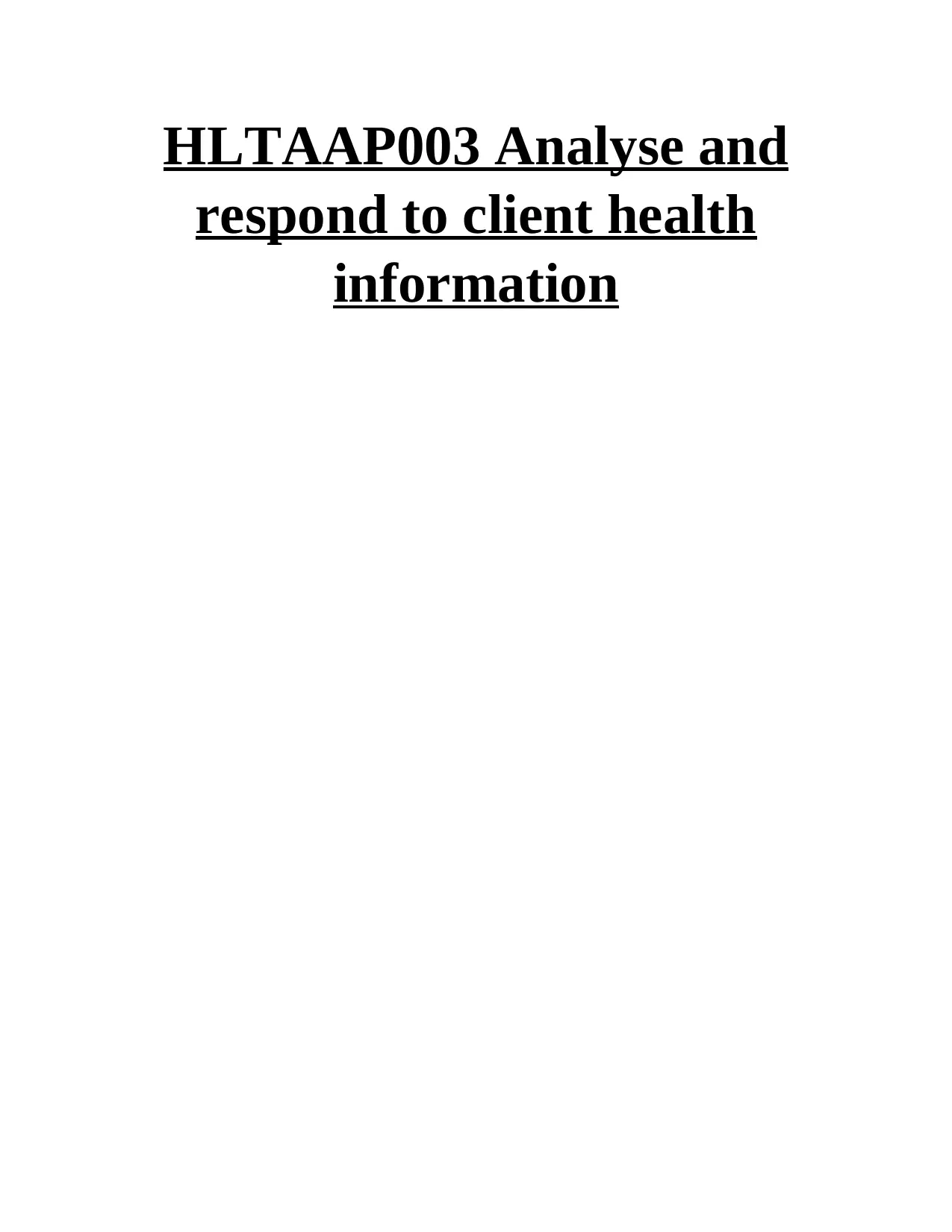
HLTAAP003 Analyse and
respond to client health
information
respond to client health
information
Secure Best Marks with AI Grader
Need help grading? Try our AI Grader for instant feedback on your assignments.

TABLE OF CONTENTS
ASSESSMENT TASK 1.................................................................................................................3
REFERENCES................................................................................................................................8
ASSESSMENT TASK 1.................................................................................................................3
REFERENCES................................................................................................................................8
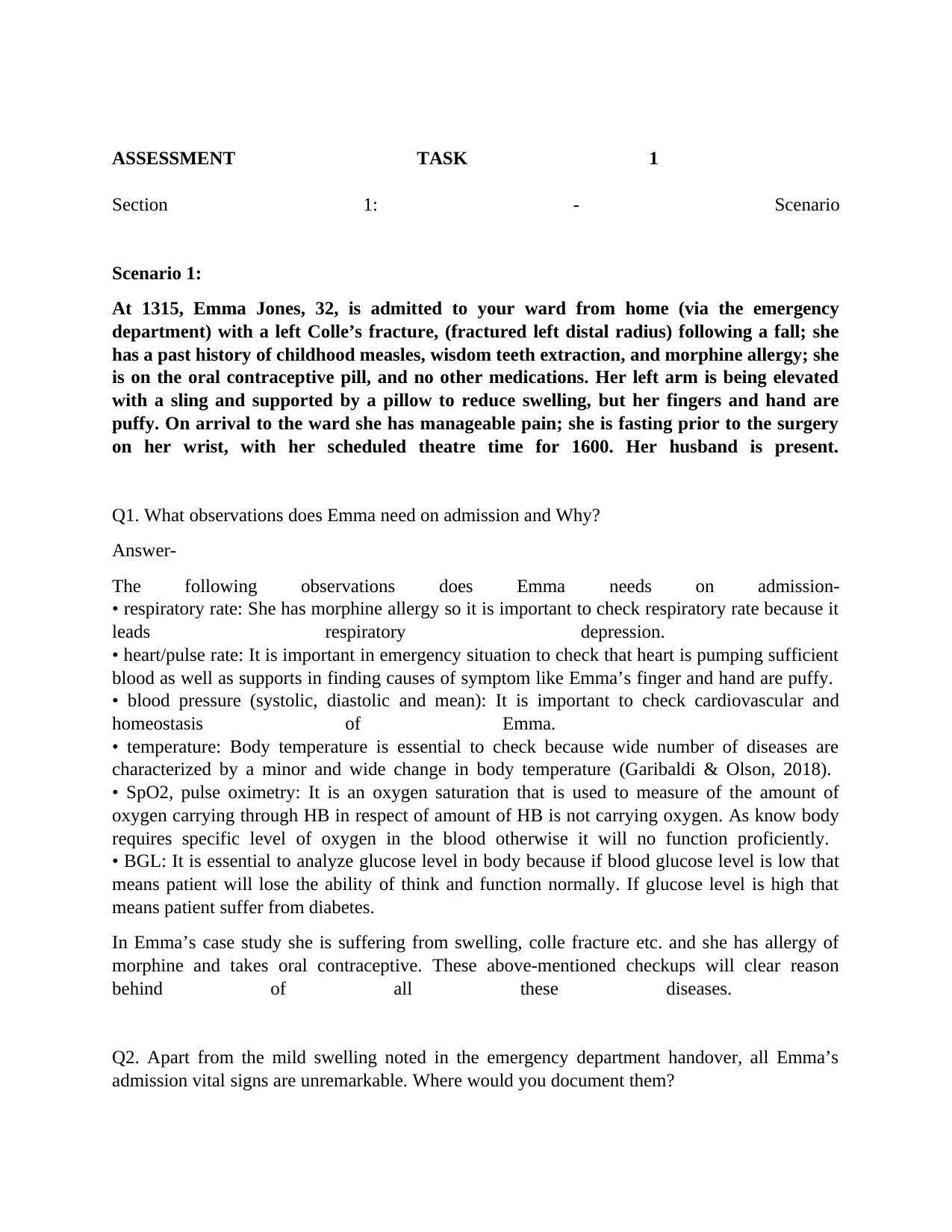
ASSESSMENT TASK 1
Section 1: - Scenario
Scenario 1:
At 1315, Emma Jones, 32, is admitted to your ward from home (via the emergency
department) with a left Colle’s fracture, (fractured left distal radius) following a fall; she
has a past history of childhood measles, wisdom teeth extraction, and morphine allergy; she
is on the oral contraceptive pill, and no other medications. Her left arm is being elevated
with a sling and supported by a pillow to reduce swelling, but her fingers and hand are
puffy. On arrival to the ward she has manageable pain; she is fasting prior to the surgery
on her wrist, with her scheduled theatre time for 1600. Her husband is present.
Q1. What observations does Emma need on admission and Why?
Answer-
The following observations does Emma needs on admission-
• respiratory rate: She has morphine allergy so it is important to check respiratory rate because it
leads respiratory depression.
• heart/pulse rate: It is important in emergency situation to check that heart is pumping sufficient
blood as well as supports in finding causes of symptom like Emma’s finger and hand are puffy.
• blood pressure (systolic, diastolic and mean): It is important to check cardiovascular and
homeostasis of Emma.
• temperature: Body temperature is essential to check because wide number of diseases are
characterized by a minor and wide change in body temperature (Garibaldi & Olson, 2018).
• SpO2, pulse oximetry: It is an oxygen saturation that is used to measure of the amount of
oxygen carrying through HB in respect of amount of HB is not carrying oxygen. As know body
requires specific level of oxygen in the blood otherwise it will no function proficiently.
• BGL: It is essential to analyze glucose level in body because if blood glucose level is low that
means patient will lose the ability of think and function normally. If glucose level is high that
means patient suffer from diabetes.
In Emma’s case study she is suffering from swelling, colle fracture etc. and she has allergy of
morphine and takes oral contraceptive. These above-mentioned checkups will clear reason
behind of all these diseases.
Q2. Apart from the mild swelling noted in the emergency department handover, all Emma’s
admission vital signs are unremarkable. Where would you document them?
Section 1: - Scenario
Scenario 1:
At 1315, Emma Jones, 32, is admitted to your ward from home (via the emergency
department) with a left Colle’s fracture, (fractured left distal radius) following a fall; she
has a past history of childhood measles, wisdom teeth extraction, and morphine allergy; she
is on the oral contraceptive pill, and no other medications. Her left arm is being elevated
with a sling and supported by a pillow to reduce swelling, but her fingers and hand are
puffy. On arrival to the ward she has manageable pain; she is fasting prior to the surgery
on her wrist, with her scheduled theatre time for 1600. Her husband is present.
Q1. What observations does Emma need on admission and Why?
Answer-
The following observations does Emma needs on admission-
• respiratory rate: She has morphine allergy so it is important to check respiratory rate because it
leads respiratory depression.
• heart/pulse rate: It is important in emergency situation to check that heart is pumping sufficient
blood as well as supports in finding causes of symptom like Emma’s finger and hand are puffy.
• blood pressure (systolic, diastolic and mean): It is important to check cardiovascular and
homeostasis of Emma.
• temperature: Body temperature is essential to check because wide number of diseases are
characterized by a minor and wide change in body temperature (Garibaldi & Olson, 2018).
• SpO2, pulse oximetry: It is an oxygen saturation that is used to measure of the amount of
oxygen carrying through HB in respect of amount of HB is not carrying oxygen. As know body
requires specific level of oxygen in the blood otherwise it will no function proficiently.
• BGL: It is essential to analyze glucose level in body because if blood glucose level is low that
means patient will lose the ability of think and function normally. If glucose level is high that
means patient suffer from diabetes.
In Emma’s case study she is suffering from swelling, colle fracture etc. and she has allergy of
morphine and takes oral contraceptive. These above-mentioned checkups will clear reason
behind of all these diseases.
Q2. Apart from the mild swelling noted in the emergency department handover, all Emma’s
admission vital signs are unremarkable. Where would you document them?
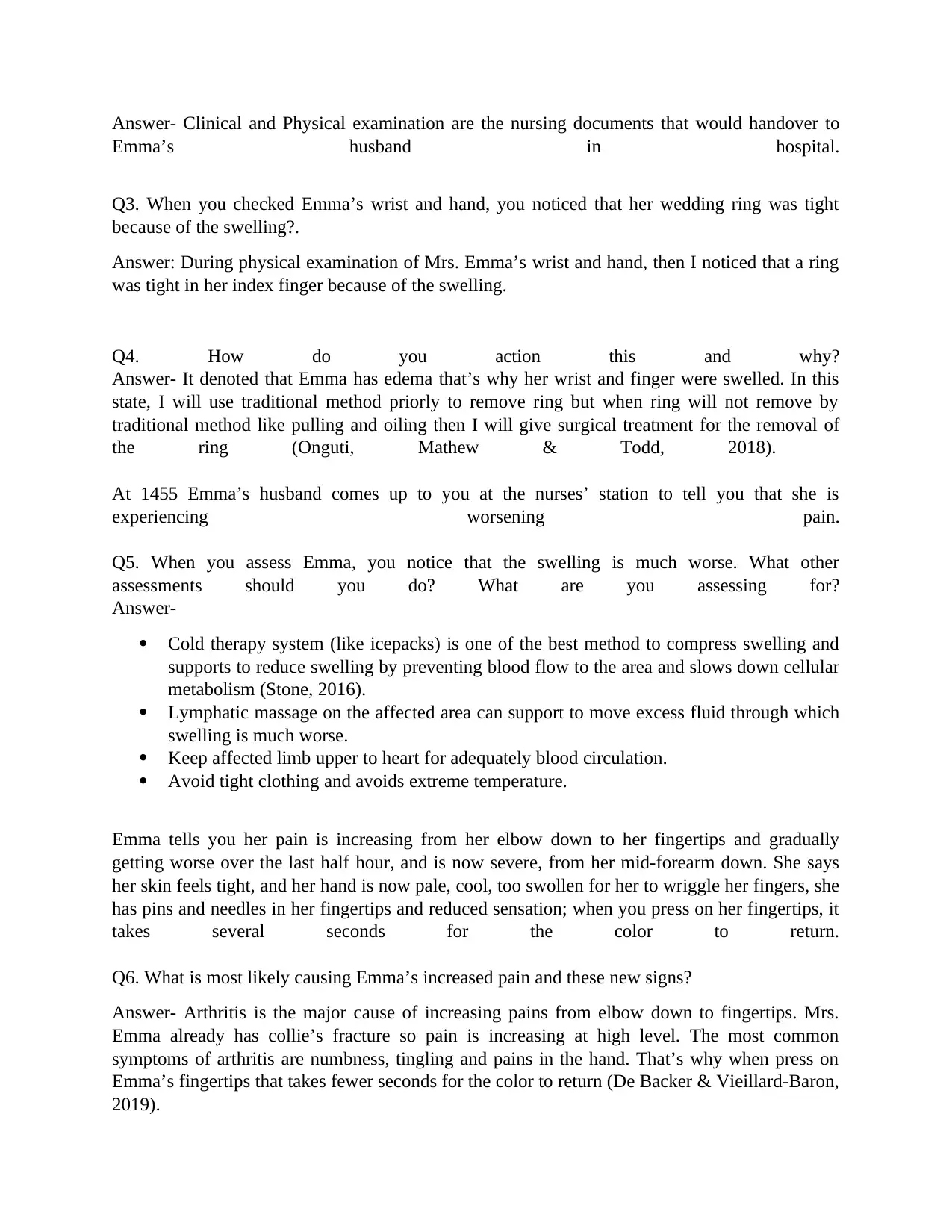
Answer- Clinical and Physical examination are the nursing documents that would handover to
Emma’s husband in hospital.
Q3. When you checked Emma’s wrist and hand, you noticed that her wedding ring was tight
because of the swelling?.
Answer: During physical examination of Mrs. Emma’s wrist and hand, then I noticed that a ring
was tight in her index finger because of the swelling.
Q4. How do you action this and why?
Answer- It denoted that Emma has edema that’s why her wrist and finger were swelled. In this
state, I will use traditional method priorly to remove ring but when ring will not remove by
traditional method like pulling and oiling then I will give surgical treatment for the removal of
the ring (Onguti, Mathew & Todd, 2018).
At 1455 Emma’s husband comes up to you at the nurses’ station to tell you that she is
experiencing worsening pain.
Q5. When you assess Emma, you notice that the swelling is much worse. What other
assessments should you do? What are you assessing for?
Answer-
Cold therapy system (like icepacks) is one of the best method to compress swelling and
supports to reduce swelling by preventing blood flow to the area and slows down cellular
metabolism (Stone, 2016).
Lymphatic massage on the affected area can support to move excess fluid through which
swelling is much worse.
Keep affected limb upper to heart for adequately blood circulation.
Avoid tight clothing and avoids extreme temperature.
Emma tells you her pain is increasing from her elbow down to her fingertips and gradually
getting worse over the last half hour, and is now severe, from her mid-forearm down. She says
her skin feels tight, and her hand is now pale, cool, too swollen for her to wriggle her fingers, she
has pins and needles in her fingertips and reduced sensation; when you press on her fingertips, it
takes several seconds for the color to return.
Q6. What is most likely causing Emma’s increased pain and these new signs?
Answer- Arthritis is the major cause of increasing pains from elbow down to fingertips. Mrs.
Emma already has collie’s fracture so pain is increasing at high level. The most common
symptoms of arthritis are numbness, tingling and pains in the hand. That’s why when press on
Emma’s fingertips that takes fewer seconds for the color to return (De Backer & Vieillard-Baron,
2019).
Emma’s husband in hospital.
Q3. When you checked Emma’s wrist and hand, you noticed that her wedding ring was tight
because of the swelling?.
Answer: During physical examination of Mrs. Emma’s wrist and hand, then I noticed that a ring
was tight in her index finger because of the swelling.
Q4. How do you action this and why?
Answer- It denoted that Emma has edema that’s why her wrist and finger were swelled. In this
state, I will use traditional method priorly to remove ring but when ring will not remove by
traditional method like pulling and oiling then I will give surgical treatment for the removal of
the ring (Onguti, Mathew & Todd, 2018).
At 1455 Emma’s husband comes up to you at the nurses’ station to tell you that she is
experiencing worsening pain.
Q5. When you assess Emma, you notice that the swelling is much worse. What other
assessments should you do? What are you assessing for?
Answer-
Cold therapy system (like icepacks) is one of the best method to compress swelling and
supports to reduce swelling by preventing blood flow to the area and slows down cellular
metabolism (Stone, 2016).
Lymphatic massage on the affected area can support to move excess fluid through which
swelling is much worse.
Keep affected limb upper to heart for adequately blood circulation.
Avoid tight clothing and avoids extreme temperature.
Emma tells you her pain is increasing from her elbow down to her fingertips and gradually
getting worse over the last half hour, and is now severe, from her mid-forearm down. She says
her skin feels tight, and her hand is now pale, cool, too swollen for her to wriggle her fingers, she
has pins and needles in her fingertips and reduced sensation; when you press on her fingertips, it
takes several seconds for the color to return.
Q6. What is most likely causing Emma’s increased pain and these new signs?
Answer- Arthritis is the major cause of increasing pains from elbow down to fingertips. Mrs.
Emma already has collie’s fracture so pain is increasing at high level. The most common
symptoms of arthritis are numbness, tingling and pains in the hand. That’s why when press on
Emma’s fingertips that takes fewer seconds for the color to return (De Backer & Vieillard-Baron,
2019).
Secure Best Marks with AI Grader
Need help grading? Try our AI Grader for instant feedback on your assignments.
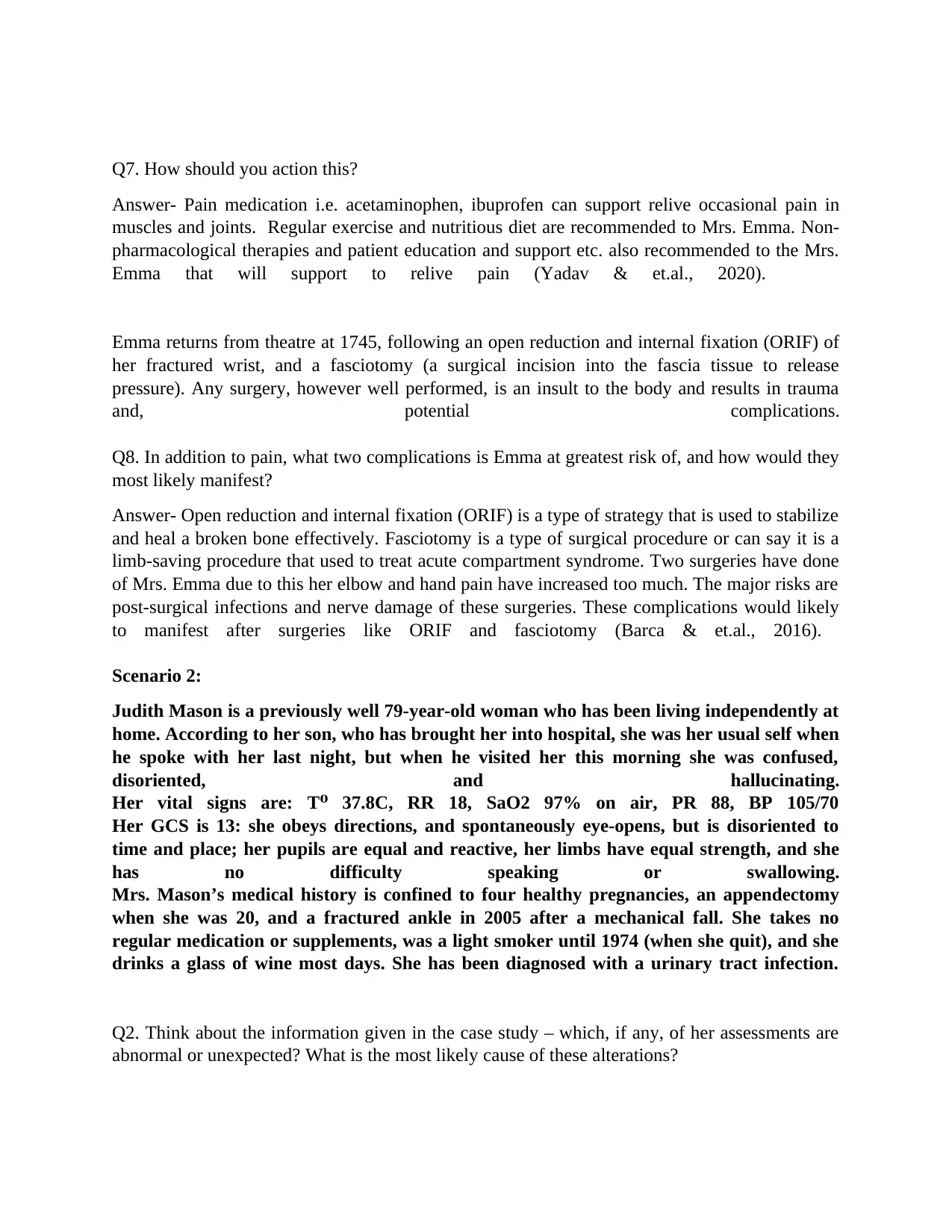
Q7. How should you action this?
Answer- Pain medication i.e. acetaminophen, ibuprofen can support relive occasional pain in
muscles and joints. Regular exercise and nutritious diet are recommended to Mrs. Emma. Non-
pharmacological therapies and patient education and support etc. also recommended to the Mrs.
Emma that will support to relive pain (Yadav & et.al., 2020).
Emma returns from theatre at 1745, following an open reduction and internal fixation (ORIF) of
her fractured wrist, and a fasciotomy (a surgical incision into the fascia tissue to release
pressure). Any surgery, however well performed, is an insult to the body and results in trauma
and, potential complications.
Q8. In addition to pain, what two complications is Emma at greatest risk of, and how would they
most likely manifest?
Answer- Open reduction and internal fixation (ORIF) is a type of strategy that is used to stabilize
and heal a broken bone effectively. Fasciotomy is a type of surgical procedure or can say it is a
limb-saving procedure that used to treat acute compartment syndrome. Two surgeries have done
of Mrs. Emma due to this her elbow and hand pain have increased too much. The major risks are
post-surgical infections and nerve damage of these surgeries. These complications would likely
to manifest after surgeries like ORIF and fasciotomy (Barca & et.al., 2016).
Scenario 2:
Judith Mason is a previously well 79-year-old woman who has been living independently at
home. According to her son, who has brought her into hospital, she was her usual self when
he spoke with her last night, but when he visited her this morning she was confused,
disoriented, and hallucinating.
Her vital signs are: T 37.8C, RR 18, SaO2 97% on air, PR 88, BP 105/70⁰
Her GCS is 13: she obeys directions, and spontaneously eye-opens, but is disoriented to
time and place; her pupils are equal and reactive, her limbs have equal strength, and she
has no difficulty speaking or swallowing.
Mrs. Mason’s medical history is confined to four healthy pregnancies, an appendectomy
when she was 20, and a fractured ankle in 2005 after a mechanical fall. She takes no
regular medication or supplements, was a light smoker until 1974 (when she quit), and she
drinks a glass of wine most days. She has been diagnosed with a urinary tract infection.
Q2. Think about the information given in the case study – which, if any, of her assessments are
abnormal or unexpected? What is the most likely cause of these alterations?
Answer- Pain medication i.e. acetaminophen, ibuprofen can support relive occasional pain in
muscles and joints. Regular exercise and nutritious diet are recommended to Mrs. Emma. Non-
pharmacological therapies and patient education and support etc. also recommended to the Mrs.
Emma that will support to relive pain (Yadav & et.al., 2020).
Emma returns from theatre at 1745, following an open reduction and internal fixation (ORIF) of
her fractured wrist, and a fasciotomy (a surgical incision into the fascia tissue to release
pressure). Any surgery, however well performed, is an insult to the body and results in trauma
and, potential complications.
Q8. In addition to pain, what two complications is Emma at greatest risk of, and how would they
most likely manifest?
Answer- Open reduction and internal fixation (ORIF) is a type of strategy that is used to stabilize
and heal a broken bone effectively. Fasciotomy is a type of surgical procedure or can say it is a
limb-saving procedure that used to treat acute compartment syndrome. Two surgeries have done
of Mrs. Emma due to this her elbow and hand pain have increased too much. The major risks are
post-surgical infections and nerve damage of these surgeries. These complications would likely
to manifest after surgeries like ORIF and fasciotomy (Barca & et.al., 2016).
Scenario 2:
Judith Mason is a previously well 79-year-old woman who has been living independently at
home. According to her son, who has brought her into hospital, she was her usual self when
he spoke with her last night, but when he visited her this morning she was confused,
disoriented, and hallucinating.
Her vital signs are: T 37.8C, RR 18, SaO2 97% on air, PR 88, BP 105/70⁰
Her GCS is 13: she obeys directions, and spontaneously eye-opens, but is disoriented to
time and place; her pupils are equal and reactive, her limbs have equal strength, and she
has no difficulty speaking or swallowing.
Mrs. Mason’s medical history is confined to four healthy pregnancies, an appendectomy
when she was 20, and a fractured ankle in 2005 after a mechanical fall. She takes no
regular medication or supplements, was a light smoker until 1974 (when she quit), and she
drinks a glass of wine most days. She has been diagnosed with a urinary tract infection.
Q2. Think about the information given in the case study – which, if any, of her assessments are
abnormal or unexpected? What is the most likely cause of these alterations?
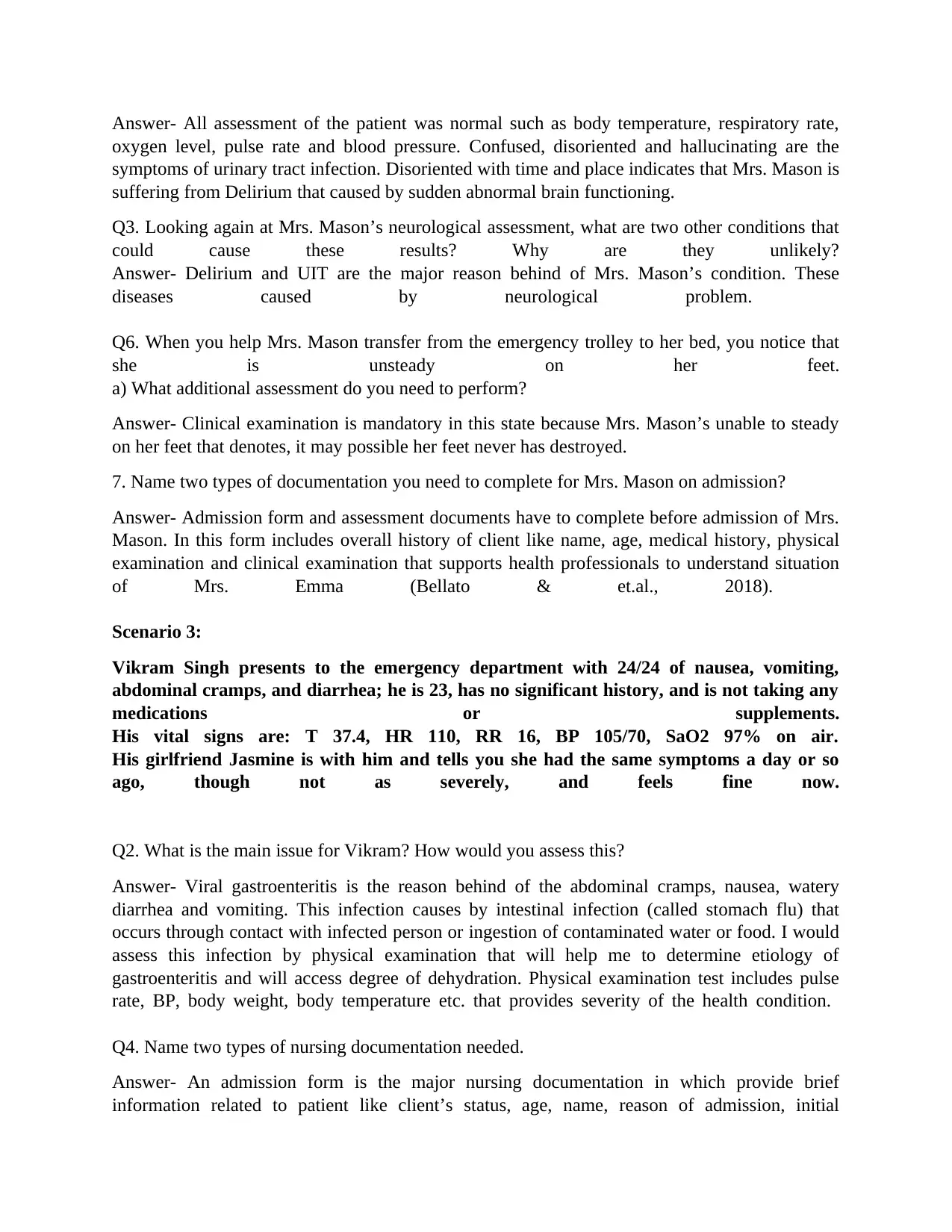
Answer- All assessment of the patient was normal such as body temperature, respiratory rate,
oxygen level, pulse rate and blood pressure. Confused, disoriented and hallucinating are the
symptoms of urinary tract infection. Disoriented with time and place indicates that Mrs. Mason is
suffering from Delirium that caused by sudden abnormal brain functioning.
Q3. Looking again at Mrs. Mason’s neurological assessment, what are two other conditions that
could cause these results? Why are they unlikely?
Answer- Delirium and UIT are the major reason behind of Mrs. Mason’s condition. These
diseases caused by neurological problem.
Q6. When you help Mrs. Mason transfer from the emergency trolley to her bed, you notice that
she is unsteady on her feet.
a) What additional assessment do you need to perform?
Answer- Clinical examination is mandatory in this state because Mrs. Mason’s unable to steady
on her feet that denotes, it may possible her feet never has destroyed.
7. Name two types of documentation you need to complete for Mrs. Mason on admission?
Answer- Admission form and assessment documents have to complete before admission of Mrs.
Mason. In this form includes overall history of client like name, age, medical history, physical
examination and clinical examination that supports health professionals to understand situation
of Mrs. Emma (Bellato & et.al., 2018).
Scenario 3:
Vikram Singh presents to the emergency department with 24/24 of nausea, vomiting,
abdominal cramps, and diarrhea; he is 23, has no significant history, and is not taking any
medications or supplements.
His vital signs are: T 37.4, HR 110, RR 16, BP 105/70, SaO2 97% on air.
His girlfriend Jasmine is with him and tells you she had the same symptoms a day or so
ago, though not as severely, and feels fine now.
Q2. What is the main issue for Vikram? How would you assess this?
Answer- Viral gastroenteritis is the reason behind of the abdominal cramps, nausea, watery
diarrhea and vomiting. This infection causes by intestinal infection (called stomach flu) that
occurs through contact with infected person or ingestion of contaminated water or food. I would
assess this infection by physical examination that will help me to determine etiology of
gastroenteritis and will access degree of dehydration. Physical examination test includes pulse
rate, BP, body weight, body temperature etc. that provides severity of the health condition.
Q4. Name two types of nursing documentation needed.
Answer- An admission form is the major nursing documentation in which provide brief
information related to patient like client’s status, age, name, reason of admission, initial
oxygen level, pulse rate and blood pressure. Confused, disoriented and hallucinating are the
symptoms of urinary tract infection. Disoriented with time and place indicates that Mrs. Mason is
suffering from Delirium that caused by sudden abnormal brain functioning.
Q3. Looking again at Mrs. Mason’s neurological assessment, what are two other conditions that
could cause these results? Why are they unlikely?
Answer- Delirium and UIT are the major reason behind of Mrs. Mason’s condition. These
diseases caused by neurological problem.
Q6. When you help Mrs. Mason transfer from the emergency trolley to her bed, you notice that
she is unsteady on her feet.
a) What additional assessment do you need to perform?
Answer- Clinical examination is mandatory in this state because Mrs. Mason’s unable to steady
on her feet that denotes, it may possible her feet never has destroyed.
7. Name two types of documentation you need to complete for Mrs. Mason on admission?
Answer- Admission form and assessment documents have to complete before admission of Mrs.
Mason. In this form includes overall history of client like name, age, medical history, physical
examination and clinical examination that supports health professionals to understand situation
of Mrs. Emma (Bellato & et.al., 2018).
Scenario 3:
Vikram Singh presents to the emergency department with 24/24 of nausea, vomiting,
abdominal cramps, and diarrhea; he is 23, has no significant history, and is not taking any
medications or supplements.
His vital signs are: T 37.4, HR 110, RR 16, BP 105/70, SaO2 97% on air.
His girlfriend Jasmine is with him and tells you she had the same symptoms a day or so
ago, though not as severely, and feels fine now.
Q2. What is the main issue for Vikram? How would you assess this?
Answer- Viral gastroenteritis is the reason behind of the abdominal cramps, nausea, watery
diarrhea and vomiting. This infection causes by intestinal infection (called stomach flu) that
occurs through contact with infected person or ingestion of contaminated water or food. I would
assess this infection by physical examination that will help me to determine etiology of
gastroenteritis and will access degree of dehydration. Physical examination test includes pulse
rate, BP, body weight, body temperature etc. that provides severity of the health condition.
Q4. Name two types of nursing documentation needed.
Answer- An admission form is the major nursing documentation in which provide brief
information related to patient like client’s status, age, name, reason of admission, initial

instruction for the patient’s care. An assessment form is another nursing document in which
includes client’s information i.e. psychological, sociological, spiritual status etc. are recorded by
licensed Registered Nurse (Flanigan & et.al., 2018). These documentations are highly needed
before admitting Mr. Vikram.
includes client’s information i.e. psychological, sociological, spiritual status etc. are recorded by
licensed Registered Nurse (Flanigan & et.al., 2018). These documentations are highly needed
before admitting Mr. Vikram.
Paraphrase This Document
Need a fresh take? Get an instant paraphrase of this document with our AI Paraphraser
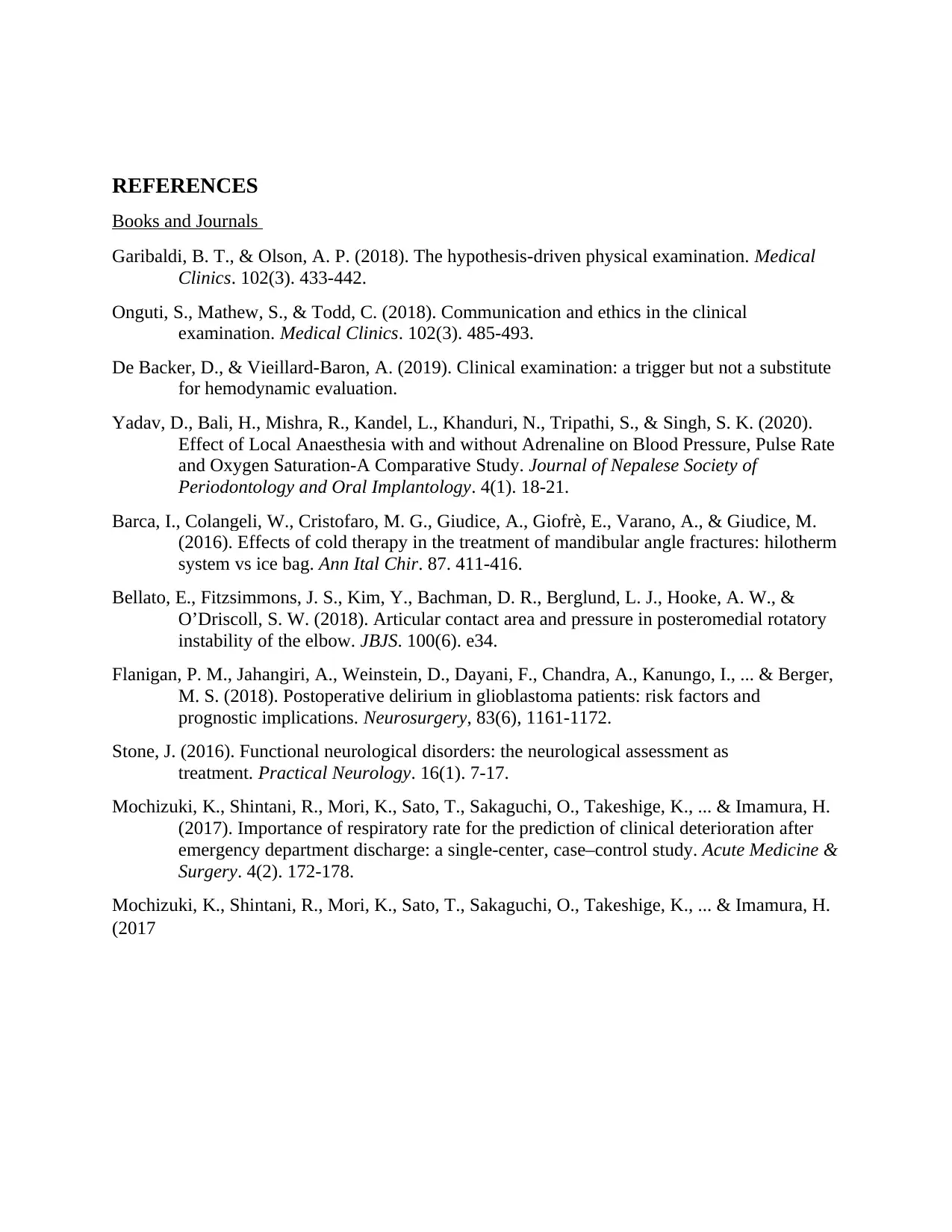
REFERENCES
Books and Journals
Garibaldi, B. T., & Olson, A. P. (2018). The hypothesis-driven physical examination. Medical
Clinics. 102(3). 433-442.
Onguti, S., Mathew, S., & Todd, C. (2018). Communication and ethics in the clinical
examination. Medical Clinics. 102(3). 485-493.
De Backer, D., & Vieillard-Baron, A. (2019). Clinical examination: a trigger but not a substitute
for hemodynamic evaluation.
Yadav, D., Bali, H., Mishra, R., Kandel, L., Khanduri, N., Tripathi, S., & Singh, S. K. (2020).
Effect of Local Anaesthesia with and without Adrenaline on Blood Pressure, Pulse Rate
and Oxygen Saturation-A Comparative Study. Journal of Nepalese Society of
Periodontology and Oral Implantology. 4(1). 18-21.
Barca, I., Colangeli, W., Cristofaro, M. G., Giudice, A., Giofrè, E., Varano, A., & Giudice, M.
(2016). Effects of cold therapy in the treatment of mandibular angle fractures: hilotherm
system vs ice bag. Ann Ital Chir. 87. 411-416.
Bellato, E., Fitzsimmons, J. S., Kim, Y., Bachman, D. R., Berglund, L. J., Hooke, A. W., &
O’Driscoll, S. W. (2018). Articular contact area and pressure in posteromedial rotatory
instability of the elbow. JBJS. 100(6). e34.
Flanigan, P. M., Jahangiri, A., Weinstein, D., Dayani, F., Chandra, A., Kanungo, I., ... & Berger,
M. S. (2018). Postoperative delirium in glioblastoma patients: risk factors and
prognostic implications. Neurosurgery, 83(6), 1161-1172.
Stone, J. (2016). Functional neurological disorders: the neurological assessment as
treatment. Practical Neurology. 16(1). 7-17.
Mochizuki, K., Shintani, R., Mori, K., Sato, T., Sakaguchi, O., Takeshige, K., ... & Imamura, H.
(2017). Importance of respiratory rate for the prediction of clinical deterioration after
emergency department discharge: a single‐center, case–control study. Acute Medicine &
Surgery. 4(2). 172-178.
Mochizuki, K., Shintani, R., Mori, K., Sato, T., Sakaguchi, O., Takeshige, K., ... & Imamura, H.
(2017
Books and Journals
Garibaldi, B. T., & Olson, A. P. (2018). The hypothesis-driven physical examination. Medical
Clinics. 102(3). 433-442.
Onguti, S., Mathew, S., & Todd, C. (2018). Communication and ethics in the clinical
examination. Medical Clinics. 102(3). 485-493.
De Backer, D., & Vieillard-Baron, A. (2019). Clinical examination: a trigger but not a substitute
for hemodynamic evaluation.
Yadav, D., Bali, H., Mishra, R., Kandel, L., Khanduri, N., Tripathi, S., & Singh, S. K. (2020).
Effect of Local Anaesthesia with and without Adrenaline on Blood Pressure, Pulse Rate
and Oxygen Saturation-A Comparative Study. Journal of Nepalese Society of
Periodontology and Oral Implantology. 4(1). 18-21.
Barca, I., Colangeli, W., Cristofaro, M. G., Giudice, A., Giofrè, E., Varano, A., & Giudice, M.
(2016). Effects of cold therapy in the treatment of mandibular angle fractures: hilotherm
system vs ice bag. Ann Ital Chir. 87. 411-416.
Bellato, E., Fitzsimmons, J. S., Kim, Y., Bachman, D. R., Berglund, L. J., Hooke, A. W., &
O’Driscoll, S. W. (2018). Articular contact area and pressure in posteromedial rotatory
instability of the elbow. JBJS. 100(6). e34.
Flanigan, P. M., Jahangiri, A., Weinstein, D., Dayani, F., Chandra, A., Kanungo, I., ... & Berger,
M. S. (2018). Postoperative delirium in glioblastoma patients: risk factors and
prognostic implications. Neurosurgery, 83(6), 1161-1172.
Stone, J. (2016). Functional neurological disorders: the neurological assessment as
treatment. Practical Neurology. 16(1). 7-17.
Mochizuki, K., Shintani, R., Mori, K., Sato, T., Sakaguchi, O., Takeshige, K., ... & Imamura, H.
(2017). Importance of respiratory rate for the prediction of clinical deterioration after
emergency department discharge: a single‐center, case–control study. Acute Medicine &
Surgery. 4(2). 172-178.
Mochizuki, K., Shintani, R., Mori, K., Sato, T., Sakaguchi, O., Takeshige, K., ... & Imamura, H.
(2017
1 out of 8
Your All-in-One AI-Powered Toolkit for Academic Success.
+13062052269
info@desklib.com
Available 24*7 on WhatsApp / Email
![[object Object]](/_next/static/media/star-bottom.7253800d.svg)
Unlock your academic potential
© 2024 | Zucol Services PVT LTD | All rights reserved.

